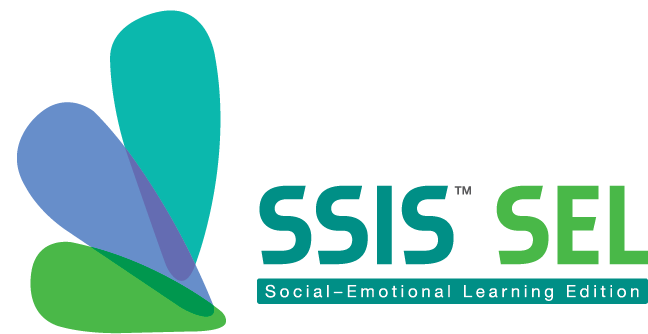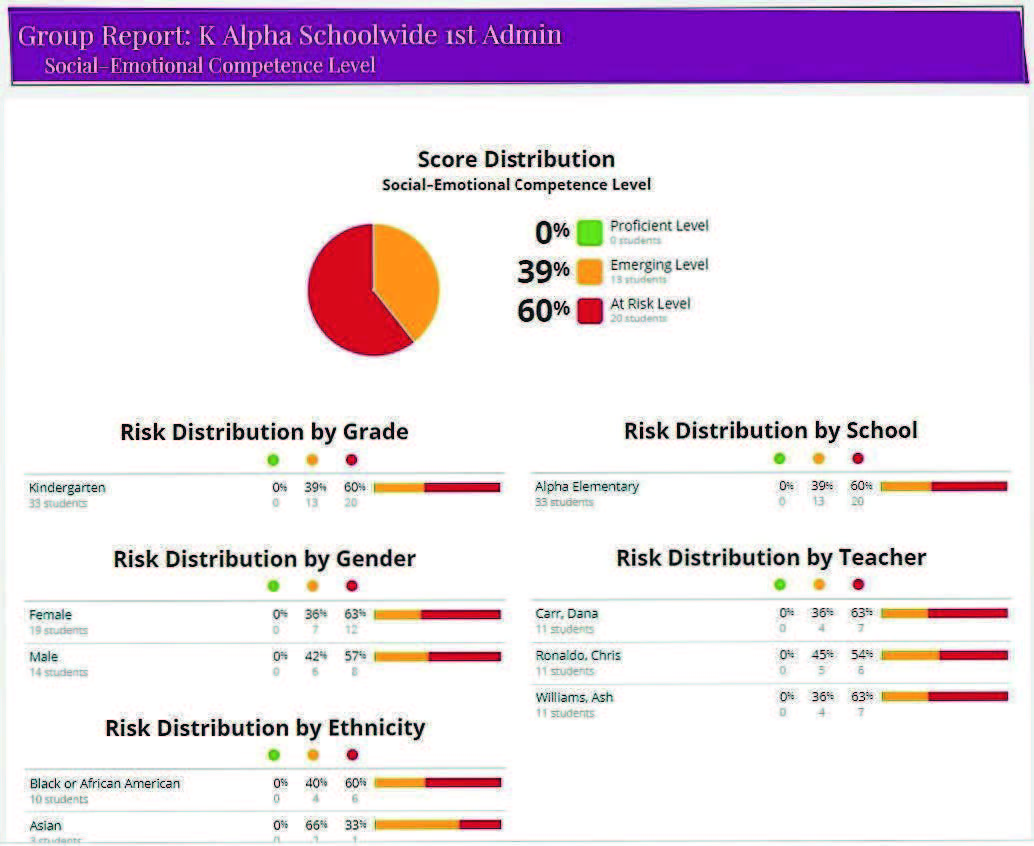Brief #1 – Screening and Monitoring the Development of SEL
Intervention Simplified
Screening and Monitoring the Development of Social Emotional Learning
Stephen N. Elliott, PhD

Smartly designed social-emotional learning (SEL) programs are driven by a sound assessment of children’s social–emotional strengths and weaknesses. Sound SEL screening assessments are theoretically well aligned with a competency model guiding intervention; are time efficient to complete; yield reliable scores; and, perhaps most importantly, are proven to yield scores predictive of children’s
SEL functioning. Because SEL skills are commonly thought to influence students’ academic accomplishments, it is also desirable to concurrently screen for key academic behaviors and their related achievement outcomes. This intervention brief describes how to screen a classroom or an entire school and identify children’s SEL skill areas that need improvement using the SSIS SEL Edition Screening/Progress Monitoring Scales (Elliott & Gresham, 2017a).
Overview of the SSIS SEL Edition screening/progress monitoring scales
The SSIS SEL Edition screener is a brief, time efficient (30 mins), classwide-focused, criterion-referenced set of rating rubrics completed by teachers. Students’ strengths and improvement areas are assessed across five SEL domains (self-awareness, self-management, social awareness, relationship skills, responsible decision making) and three academic competencies (motivation to learn, reading skills, and mathematics skills).
These performance level rubrics can be used with students in preschool through Grade 12 as a universal screening tool to assess their social–emotional and academic functioning and can also be used as a monitoring tool to evaluate changes in social–emotional and academic functioning several times over a period of weeks for a comprehensive intervention.
SSIS SEL Screener
The SSIS SEL screener provides a definition for each SEL domain based on the Collaborative for Academic, Social, and Emotional Learning (CASEL) competency framework (CASEL, 2012). Each domain is assessed via a five- level criterion-referenced rubric that defines behaviors and skills associated with typical performance of a student rated at each level. The rating rubric for Relationship Skills illustrates the assessment format used to rate each of the eight skill areas for each student. Specifically, a rating of 3, 4, or 5 indicates a student is generally proficient on the assessed competency; a rating of 2 typically indicates emerging demonstration of skills; and a rating of 1 indicates the demonstration of an at-risk level of skills in the assessed competency domain.
Relationship Skills
Establishing and maintaining healthy and rewarding relationships with diverse individuals and groups. This includes communicating clearly, listening actively, cooperating, resisting inappropriate social pressure, negotiating conflict constructively, and seeking and offering help when needed.
Level 5
A student at this performance level demonstrates most of the following:
• Exceptional communication and cooperation skills
• Excellent self-control and ability to resist inappropriate peer pressure
• Outstanding skills for negotiating conflict solutions
• Excellent understanding of when to ask for help and when to offer help to others
A student at this performance level generally does not need additional instruction to improve his/her relationship skills.
Level 4
A student at this performance level demonstrates most of the following:
• Proficient communication and cooperation skills
• Very good self-control and ability to resist inappropriate peer pressure
• Substantial skills for negotiating conflict situations
• Very good understanding of when to ask for help and when to offer help to others
A student at this performance level may benefit from additional instruction to improve his/her relationship skills.
Level 3
A student at this performance level demonstrates most of the following:
• Adequate communication and cooperation skills
• Good self-control and ability to resist inappropriate peer pressure
• Some skills for negotiating conflict situations
• Good understanding of when to ask for help and when to offer help to others
A student at this performance level often is in need of additional instruction to improve his/her relationship skills.
Level 2
A student at this performance level demonstrates most of the following:
• Few communication and cooperation skills
• Limited self-control and ability to resist inappropriate peer pressure
• Limited skills for negotiating conflict situations
• Poor understanding of when to ask for help and when to offer help to others
A student at this performance level is in need of additional instruction to improve his/her relationship skills.
Level 1
A student at this performance level demonstrates most of the following:
• Very few communication and cooperation skills
• Very limited self-control and ability to resist inappropriate peer pressure
• Very poor skills for negotiating conflict situations
• Very poor understanding of when to ask for help and when to offer help to others
A student at this performance level is in need of additional intensive instruction to improve his/her relationship skills.
Recent research on the SSIS SEL screener with nearly 300 children in one elementary school indicated the teacher-completed screener was well-aligned with the CASEL model of SEL competencies and provided educators a time-efficient, sensitive, and reliable measure that effectively identified students at-risk socially and academically (Elliott, Davies, Frey, Gresham, & Cooper, 2018). Teachers also reported the screener was easy to use and provided straight-forward results that linked to the SSIS SEL CIP.
Reporting results using Review360®
Review360 is a versatile scoring and reporting tool for a number of social behavior assessments. The SSIS SEL Edition screener provides several types of reports based on a common framework where a Social–Emotional Composite score is the sum of the five social–emotional rubrics ratings, and an Academic Functioning Composite score is the sum of the motivation to learn and academic skill area rubric ratings. The figure below illustrates a group Social–Emotional Competence Level report for a schoolwide screening of all kindergarteners. It reports current SEL functioning at three levels: Proficient Level in green, Emerging Level in orange, and At-Risk Level in red for various subgroups (i.e., grade, gender, ethnicity, school, and teacher).
This comprehensive report is organized to address six questions:
(1) How many students were screened?
(2) What percentages of these students were identified at each level of social–emotional competence?
(3) What percentage of these students were identified at each level of academic competence?
(4) Based on the screening for the entire group, which areas of social–emotional competence are relative strengths and what areas need more development?
(5) Based on the screening for the entire group, which areas of academic functioning are relative strengths and which areas need more development?
(6) Given the assessment results, which social–emotional skills are priorities for intervention? Excerpts from a report regarding questions 4 and 6 are illustrated to facilitate intervention decision making.
The answers to the intervention priorities question (#6) indicate the SSIS SEL Edition Classwide Intervention Program (CIP; Elliott & Gresham, 2017b) skill units that are aligned with each of the SEL domains screened.
For example, in the picture to the right, the SEL domain of Social Awareness is in red to indicate it is the relatively lowest functioning area for the group of kindergartners screened.
This is not a surprising result from a developmental perspective because many young children have yet to develop the cognitive skills and emotional understanding capability to consider the perspective of others, an action fundamental to social awareness. However, if this area is selected for development, the SSIS SEL Edition CIP skill units focusing on Do nice things for others, Stand up for others, and Make others feel better are candidates to teach.
Social Awareness
Avg. Rating: 1.94
# Students Emerging/At-Risk: 27
Skill Units
10. Do nice things for others.
19. Stand up for others.
20. Make others feel better.
Intensive Skill Development Needed
The screening results also show that the other four SEL domains, pictured below are each at the Emerging Level (orange) and are areas many students can improve their skills. Also listed are the specific skill units to teach for improving each of these SEL domains when creating a strong intervention program.
Self-Awareness
Avg. Rating: 2.18
# Students Emerging/At-Risk: 23
Skill Units
5. Ask for help.
11. Tell others about your skills.
22. Be positive about the future.
Skill Development Needed
Relationship Skills
Avg. Rating: 2.18
# Students Emerging/At-Risk: 24
Skill Units
2. Say please and thank you.
6. Take turns when you talk.
7. Get along with others.
16. Ask others to do things with you.
17. Introduce yourself to others.
21. Make compromises.
Skill Development Needed
Self-Management
Avg. Rating: 2.09
# Students Emerging/At-Risk: 24
Skill Units
1. Listing to others.
3. Follow the rules.
4. Pay attention to your work.
8. Stay calm with others.
13. Express your feelings.
18. Stay calm when pushed of hit.
Skill Development Needed
Responsible Decision Making
Avg. Rating: 2.06
# Students Emerging/At-Risk: 24
Skill Units
9. Do the right thing.
12. Own your actions.
14. Respect other people’s things.
15. Do your part in a group.
23. Listen to different ideas.
Skill Development Needed
More information on SEL programs
The subsequent briefs in this Intervention Simplified series include:
(1) how to teach a key skill in each of the five SEL domains
(2) how to monitor students’ progress and outcomes of an SEL intervention program.
References
Collaborative for Academic, Social, and Emotional Learning. (2012). Effective social and emotional learning programs. Retrieved from https://casel.org/wp-content/uploads/2016/01/2013-casel-guide-1.pdf
Elliott, S.N., Davies, M.D., Frey, J.R., Gresham, F.M., & Cooper, G. (2018). Development and validation
of a social emotional learning assessment for universal screening. Journal of Applied Developmental Psychology, 55, 39-51. doi: 10.1016/j.appdev.2017.06.002.
Elliott, S. N., & Gresham, F. M. (2017a). SSIS SEL Edition Screening/Progress Monitoring Scales. Bloomington, MN: NCS Pearson.
Elliott, S. N., & Gresham, F. M. (2017b). SSIS SEL Edition Classwide Intervention Program manual. Bloomington, MN: NCS Pearson.
Stephen N. Elliott, PhD, is the Mickelson Foundation Professor at Arizona State University and the co-author of the SSIS SEL Edition Assessments and Classwide Intervention Program.
© 2018 Pearson Education, Inc. or its affiliates. All rights reserved. Pearson and SSIS are trademarks, in the US and/or other countries, of Pearson plc. LRNAS15520 EL 9/18

